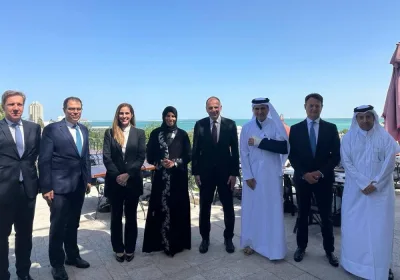Qatar's non-energy private sector economy ended 2020 with another above-par rate of growth, paced by manufacturing, construction, wholesale and retail and services sectors, according to the Purchasing Managers’ Index (PMI) December data.
Total business activity grew at a relatively marked pace, continuing the trend shown since the rapid expansion in July and August as the economy bounced back from the lockdown-induced downturn in the second quarter (Q2) of 2020, said the PMI survey of the Qatar Financial Centre (QFC).
The new business continued to expand at a rate above the long-run survey average, while outstanding work rose the most since July 2018; signalling rising pressure from demand on business capacity.
Firms continued to boost employment and wages while input purchase prices continued to fall on average, allowing companies to hold prices charged stable, it said.
"Qatar’s PMI remained at an elevated level in December, signalling that the non-energy private sector economy continued to expand at a relatively strong pace," said Sheikha Alanoud bint Hamad al-Thani, managing director, Business Development, the QFC Authority.
The Qatar PMI indices are compiled from survey responses from a panel of 400 private sector firms, covering manufacturing, construction, wholesale, retail, and services sectors, and reflecting the structure of the non-energy economy according to official national accounts data.
The PMI eased slightly from 52.5 in November to 51.8 in December, broadly in line with the fourth quarter average of 51.9 and well above the long-run trend level of 49.6.
This hinted a solid end to 2020 for the non-energy private sector, with all five of the components of the PMI in positive territory.
The monthly PMI can be aggregated to a quarterly average to enable comparisons with official gross domestic product (GDP). Since the survey began in April 2017, the quarterly PMI has a correlation of 0.66 with the year-on-year percentage change in GDP in real terms, with a PMI reading of 50 equating to a 0.2% growth on an annual basis.
The latest official data reported a year-on-year decline of 6.1% in real terms in Q2-20, a figure heavily influenced by the lockdown measures.
The PMI data for the third quarter of 2020 are consistent with a 2.7% year-on-year increase in GDP, and data for the fourth quarter are indicating a further increase of 1%.
The year-to-date PMI data confirms Qatar’s economic trajectory is more in-line with what is observed in China and other East Asian economies with a V-shaped recovery, rather than that seen in Europe or the US, it said.
The latest PMI data said total business activity continued to expand at a relatively strong rate in December. Expansion was the strongest since Q1 2018 over the fourth quarter as a whole, excluding the post-lockdown bounce in the third quarter.
The new business continued to support overall growth of activity and demand was sufficiently strong to generate rising levels of incomplete work, it said, adding backlog growth was the strongest since July 2018.
"Business conditions have steadily improved throughout the second half of 2020, following the sharp downturn in Q2 as the economy locked down to successfully combat the coronavirus pandemic. Moreover, the volume of outstanding business is rising at the fastest rate in nearly two-and-a-half years, boding well for Q1 of 2021,” Sheikha Alanoud said.
The sub-sector data suggested that the strongest overall improvement in business conditions over Q4-20 as whole came from manufacturing, followed by construction, wholesale & retail and services respectively.
In terms of output, manufacturing registered the strongest growth for the second month running in December, which forebodes strong non-oil export performance.
The new business continued to expand at a rate above the long-run survey average, while outstanding work rose the most since July 2018; signalling rising pressure from demand on business capacity.
Firms continued to boost employment and wages while input purchase prices continued to fall on average, allowing companies to hold prices charged stable, it said.
"Qatar’s PMI remained at an elevated level in December, signalling that the non-energy private sector economy continued to expand at a relatively strong pace," said Sheikha Alanoud bint Hamad al-Thani, managing director, Business Development, the QFC Authority.
The Qatar PMI indices are compiled from survey responses from a panel of 400 private sector firms, covering manufacturing, construction, wholesale, retail, and services sectors, and reflecting the structure of the non-energy economy according to official national accounts data.
The PMI eased slightly from 52.5 in November to 51.8 in December, broadly in line with the fourth quarter average of 51.9 and well above the long-run trend level of 49.6.
This hinted a solid end to 2020 for the non-energy private sector, with all five of the components of the PMI in positive territory.
The monthly PMI can be aggregated to a quarterly average to enable comparisons with official gross domestic product (GDP). Since the survey began in April 2017, the quarterly PMI has a correlation of 0.66 with the year-on-year percentage change in GDP in real terms, with a PMI reading of 50 equating to a 0.2% growth on an annual basis.
The latest official data reported a year-on-year decline of 6.1% in real terms in Q2-20, a figure heavily influenced by the lockdown measures.
The PMI data for the third quarter of 2020 are consistent with a 2.7% year-on-year increase in GDP, and data for the fourth quarter are indicating a further increase of 1%.
The year-to-date PMI data confirms Qatar’s economic trajectory is more in-line with what is observed in China and other East Asian economies with a V-shaped recovery, rather than that seen in Europe or the US, it said.
The latest PMI data said total business activity continued to expand at a relatively strong rate in December. Expansion was the strongest since Q1 2018 over the fourth quarter as a whole, excluding the post-lockdown bounce in the third quarter.
The new business continued to support overall growth of activity and demand was sufficiently strong to generate rising levels of incomplete work, it said, adding backlog growth was the strongest since July 2018.
"Business conditions have steadily improved throughout the second half of 2020, following the sharp downturn in Q2 as the economy locked down to successfully combat the coronavirus pandemic. Moreover, the volume of outstanding business is rising at the fastest rate in nearly two-and-a-half years, boding well for Q1 of 2021,” Sheikha Alanoud said.
The sub-sector data suggested that the strongest overall improvement in business conditions over Q4-20 as whole came from manufacturing, followed by construction, wholesale & retail and services respectively.
In terms of output, manufacturing registered the strongest growth for the second month running in December, which forebodes strong non-oil export performance.




